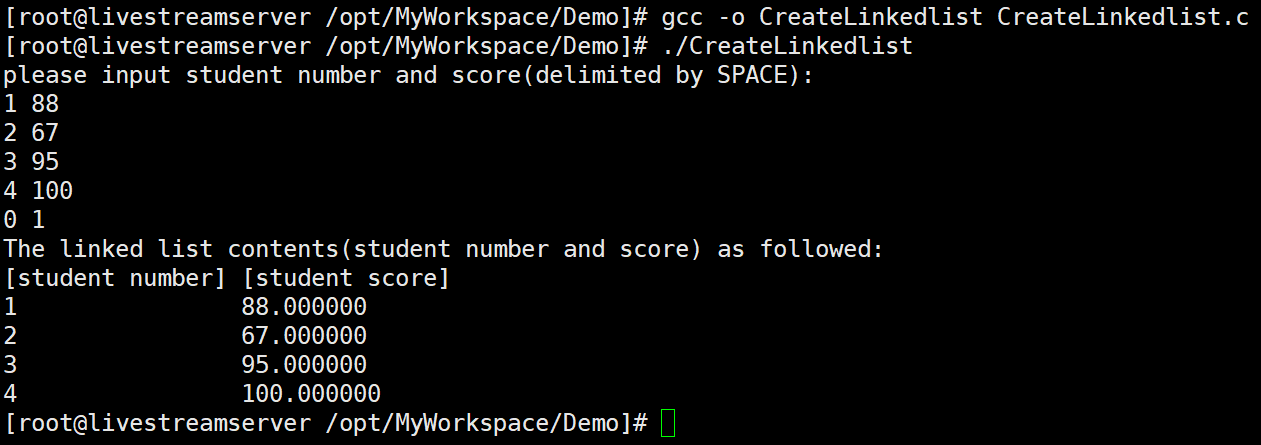链表简介(一)——创建单向动态链表及输出单向链表内容
本系列文章简要介绍链表的相关知识。
本文是系列文章的第一篇,将介绍创建单向动态链表和输出单向链表内容的方法,并给出代码示例。
1 概述
链表(linked list)是一个数据的集合,其中每个元素包含下一个元素的地址,即每个元素包含两部分内容:数据(data)和链(link)。数据部分包含可用的信息;链则将数据连在一起,它包含一个指向链表中下一个元素的指针(地址)。
说明:链表中的元素习惯上被称为节点。
链表是动态地进行存储分配的一种数据结构,与数组相比,链表可以根据需要动态地开辟内存单元,并且链表中的节点在内存中是非连续的。
2 创建单向动态链表
下面通过伪代码的形式介绍创建单向动态链表的算法。
算法:CreateLinkedlist()目的:创建单向动态链表前提:无后续:无返回:创建的链表{head <- nullnode_num <- 0tail <- new <- malloc(node) // allocate new space(*new).data <- datawhile ((*new).data != 0) // condition of finishing linked list creation{node_num <- node_num + 1if (1 == node_num){head <- new;}else{(*tail).link <- new // link tail and newtail <- new // move location of tail to new}new <- malloc(node)(*new).data <- data}(*tail).link <- nullreturn head}
3 输出单向链表内容
下面通过伪代码的形式介绍输出单向链表内容的算法。
算法:PrintLinkedlist(list)目的:输出单向链表内容前提:链表(头指针)后续:无返回:无{walker <- listwhile (walker != null){print (*walker).datawalker <- (*walker).link}}
4 代码示例
根据上述内容,可以编写创建单向动态链表及输出单向链表内容的代码示例。
代码示例内容如下:
#include <stdio.h>#include <malloc.h>#define STRUCT_LEN sizeof(struct student)struct student{int stu_num; /* student number */float stu_score; /* student score */struct student* next;};int main(){/* declaration of func */struct student* create(void);void print(struct student * list);struct student* list;list = create();print(list);return 0;}/** this is the create linked list function.* when student number is 0, create operation finish.*/struct student* create(void){struct student* head; /* head pointer name(the name of linked list) */struct student* tail; /* tail node */struct student* new; /* new node */int node_num = 0; /* node numbers of linked list */head = NULL;/* allocate a new code space */tail = new = (struct student*)malloc(STRUCT_LEN);printf("please input student number and score(delimited by SPACE): \n");scanf("%d %f", &(*new).stu_num, &(*new).stu_score);while ((new != NULL) && ((*new).stu_num != 0)){/* node number add one */node_num = node_num + 1;/* first node */if (1 == node_num){head = new;}else{/* let tail point new node, link tail and new */(*tail).next = new;/* move location of tail to new node */tail = new;}new = (struct student*)malloc(STRUCT_LEN);scanf("%d %f", &(*new).stu_num, &(*new).stu_score);}(*tail).next = NULL;return head;}/** this is the print linked list content function.*/void print(struct student * list){struct student *walker;walker = list;printf("The linked list contents(student number and score) as followed:\n");printf("[student number] [student score]\n");while (walker != NULL){printf("%d %-f\n", (*walker).stu_num, (*walker).stu_score);walker = (*walker).next;}return;}
上述代码的编译及运行结果如下:

说明:
- 在上述代码示例中,链表存储单元的动态开辟是通过 malloc 函数实现的。malloc 函数原型为“void* malloc(unsigned int size);”,其作用是在内存的动态存储区中分配一个长度为 size 的连续空间。



































还没有评论,来说两句吧...